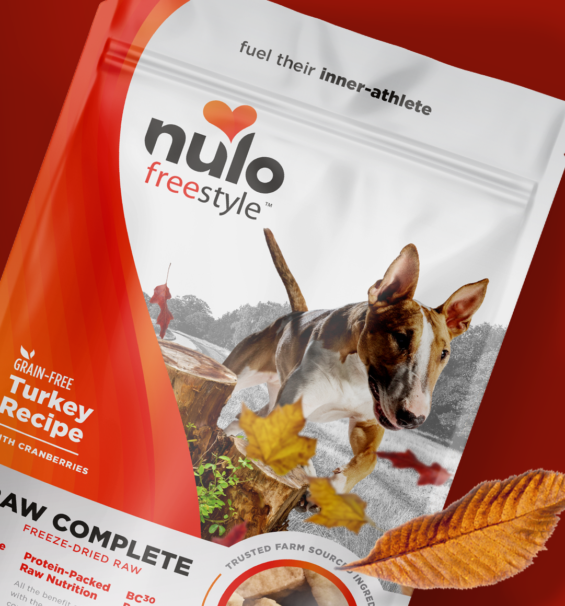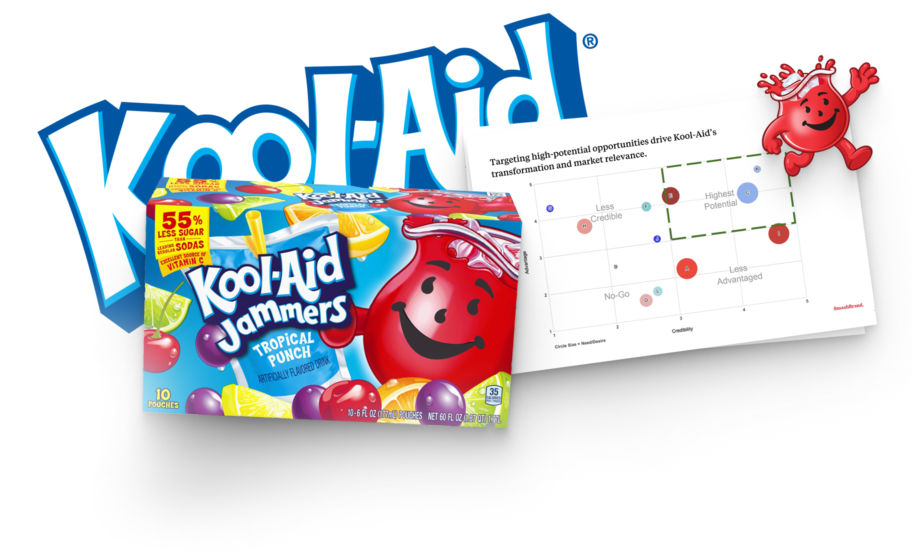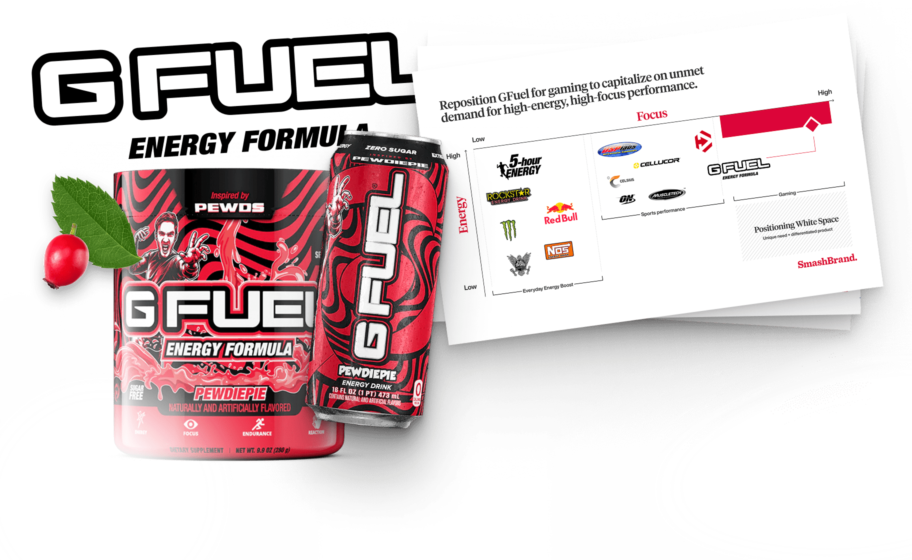Companies frequently refresh their identities to stay relevant, whether as a proactive strategy or a response to market shifts. Unfortunately, many approach corporate rebranding as a simple style upgrade, relying on subjective opinions rather than data-driven insights. In reality, a successful rebranding journey is much more than swapping an old brand for a new logo—it requires deep research, strategic development, and an understanding of brand sentiment to ensure lasting impact.
This guide will walk you through the best practices for rebranding, from refining your corporate identity to optimizing your visual branding. You’ll discover why companies choose to rebrand, the potential risks and rewards, and how to create an updated image that genuinely resonates with your audience. Keep reading to make your rebrand a success!
What is rebranding?
Rebranding changes or updates a company’s image, messaging, or identity. It can involve modifying elements such as the logo, name, packaging design, or marketing strategy to reflect better the company’s vision and appeal to its target audience. Companies employ rebranding strategies for various reasons, including adapting to market changes and repairing a damaged reputation.
Like branding for a new company, a rebrand requires the company to conduct consumer research, develop a strategy, and conduct brand testing to identify the best possible presentation for the brand. Existing brands can engage in a rebrand in two ways.
| Partial rebrand | Complete rebrand |
|---|---|
| It involves tweaking or adjusting specific elements of a brand’s identity, such as its logo or color scheme, without altering its core identity and values. | A total brand makeover involves revamping or replacing almost every element, from logo to brand messaging, to present an entirely new identity to the market. |
Rebranding vs. Refreshing
The terms “Brand refresh” and “rebrand” are often used interchangeably, but they involve fundamentally different approaches. A brand refresh is a strategic update, think of it as a facelift that fine-tunes elements such as brand color, marketing material, and messaging. This keeps the brand aligned with evolving consumer expectations without altering its core identity.
On the other hand, a rebranding initiative is a comprehensive transformation that reshapes the entire corporate identity, encompassing brand value, positioning, visual identity, and messaging. A rebranding project typically involves introducing a new logo, refining brand messaging, and recalibrating the brand’s purpose to resonate with a new or evolving audience.
Understanding these differences is crucial for a business owner. A refresh helps maintain relevance, while a complete rebrand can reposition a company for long-term success. Expert brand management ensures that changes align with strategic goals rather than just surface-level aesthetics to execute them successfully.
Read More: Rebranding vs Repositioning
Why is rebranding important?
Consumers’ preferences and behaviors constantly evolve; even the most consistent brands must adapt to stay relevant. The corporate rebranding process enables companies to align their identity with shifting market trends, ensuring they remain top-of-mind for their target audience. Without strategic updates, a brand risks losing relevance and market share.
Beyond staying current, rebranding can help businesses correct past missteps or capitalize on new opportunities. Whether adjusting after a merger, refining brand messaging, or modernizing visuals, a well-planned corporate rebranding strategy can reignite customer interest and attract new audiences.
For businesses considering how to rebrand, it’s essential to address both strategy and execution. From assessing the creative needs for a rebrand or M&A to partnering with a cost-effective rebranding agency, every step must be intentional.
Read More: When To Rebrand A Company And Its Products.
Reasons for rebranding.
We’ve discussed companies that need a rebrand proactively or reactively, but now, let’s examine each of the main reasons for rebranding a company.
01.
Outdated Image
The most common reason brands undergo the rebranding process is that they “feel” their image is outdated. However, to accurately determine whether or not the brand image is obsolete, perform consumer testing to determine how well it resonates with the target audience.
02.
Poor Reception Or Performance
At SmashBrand, much of our work involves existing brands struggling to succeed in retail. Whether the brand is a recent launch or experiencing a slow decline in performance, optimizing branding to find a competitive advantage through brand positioning is necessary to prevent delisting and customer loss.
03.
Business Evolution And Pivot
Businesses, categories, and sales channels inevitably change, and your branding often requires a change to maintain relevance with existing customers. At some point in every business’s lifecycle, a pivot strategy will be necessary if the goal is continuous growth.
04.
Mergers And Acquisitions
Changes in ownership often create misalignment between the previous brand and its new ownership branding. Finding a way to combine the two, retaining your existing customer base while capturing a new audience, is pivotal to ensuring the acquisition doesn’t hurt the brand’s performance.
05.
Damage Control
There may be a need to change the identity to ensure brand loyalty, whether due to a company decision or a changing social climate. Here is where working with an experienced brand strategist and rebranding agency comes into play. Their expertise will help alleviate the stress of the situation so that the brand can focus on getting in front of the problem with their PR team.
06.
Targeting New Audiences
To prevent brand dilution, a company may change its image in the same or a separate category to attract a new customer profile. Rebranding, where you consider the new target audience, can help you attract new customers while maintaining appeal for your existing audience.
Questions to ask when rebranding.
Before diving into this initiative, there are essential rebranding questions to ask before you begin. These questions may lead to the preliminary steps necessary for a successful rebranding. Here’s a look at three pivotal questions to ask.
Do you have enough capital for a rebrand?
Rebranding isn’t just about a logo change or a packaging redesign—it’s a full-scale transformation that requires careful financial planning. A corporate rebrand involves significant labor and material costs, from website design to in-store displays. Without a well-planned budget, your rebranding strategies may fall short, leading to inconsistencies that weaken your brand’s impact.
Following best practices for rebranding a business, ensure you assess costs upfront and explore potential investments if needed. A successful rebranding guide will help you allocate funds effectively, avoiding wasted resources. Whether you’re refining your image or undergoing a complete re branding, having sufficient capital is crucial for executing a seamless transition.
Do I have the resources?
A rebrand might be an opportunity for your company, but it will likely burden your team. So, before overfilling your plate with tasks and responsibilities, recognize the damage this strategy will have on its success. In this situation, leverage a brand development agency with a team that can efficiently handle the scope of work without slowing down company operations.
What does the company’s future look like?
Futurecasting your company is a crucial step before undertaking a rebrand. While you may have immediate needs to adjust the branding, you need to consider what the brand will look like in 3-5 years; otherwise, short-term thinking will require the brand to repeat the process in a shorter timeframe than it should. Consider how the current brand will operate, where it will operate, and whom it will serve. Consider hiring a strategic packaging design agency to help you with executing the rebrand more carefully.
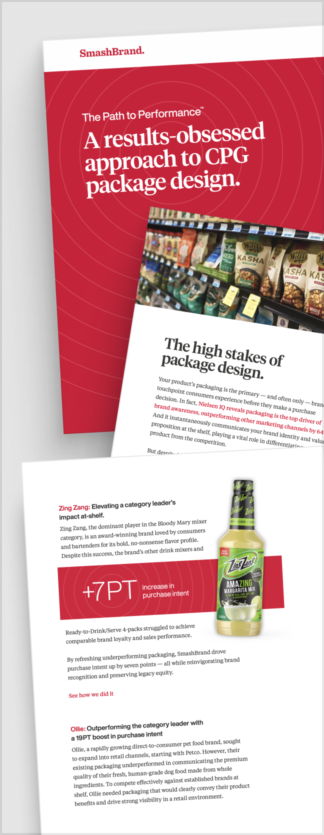
Path to Performance™
Taking a results-obsessed approach to CPG package design.
Learn how SmashBrand’s proprietary process – rooted in scientific principles, informed by data, and validated by your target audience – takes the guesswork out of package design and delivers guaranteed results.
The benefits of rebranding.
While stakeholders and the sales department may primarily care about the immediate change in revenues, a rebrand can have a host of long-term benefits for the company in terms of its performance and customer perception.
Competitor differentiation.
Whether through an ineffective initial strategy or a changing competitive landscape, a strategic rebrand performed correctly will change your brand positioning so that it differs from other brands and products within the same category. When you find white space in a category, you experience a positive impact in everything from product trial to brand recall, where consumers better recognize your brand voice.
Increase brand recognition.
A rebrand that sets itself apart encourages more significant brand equity that can carry over to a new category (with a line extension) or an entirely new market. For companies looking to scale past their current product offering, increasing brand recognition gives them significant leverage for future brand stretching.
Optimize for purchase intent.
Successful rebranding isn’t just about the image where you increase brand awareness through repetitive touchpoints. Creating a solid visual representation alongside strategic messaging increases the likelihood of consumers purchasing during their initial engagement. Purchase intent must significantly lower each product’s CAC (customer acquisition cost).
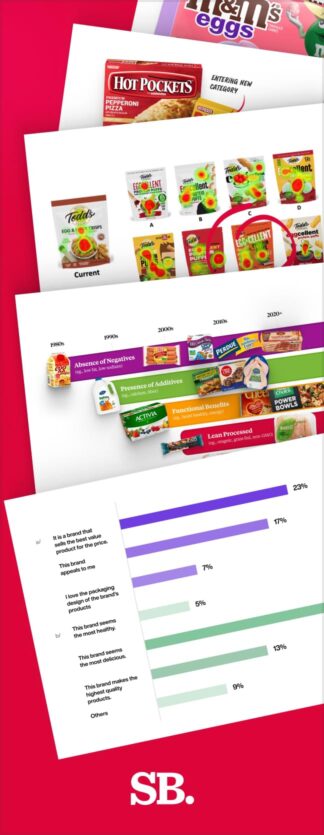
Nice Package
Don’t miss out on our monthly newsletter Nice Package!
Each month, we deliver a data-driven newsletter directly to your inbox, unpacking a critical topic in the FMCG & CPG industry.
"*" indicates required fields
The risks of rebranding.
Every brand strategy has inherent risks, but because the cost of rebranding can be so high, brands should be fully aware of what can go wrong when they don’t have the correct strategy. However, we will say that you can mitigate, if not eliminate, these risks when consumer research and brand testing (which will be discussed later in the article) are employed.
Alienating existing customers.
Many assume that we retain customers as long as we refrain from offending them with our new branding. Unfortunately, subtle changes can significantly change consumer perception. In an apparent example, a visual change will make it harder for consumers to find your product on the shelf, and if they struggle for long enough, they will try another brand.
In a less obvious case, a color change may elicit a different emotion, which may cause people to rethink what the product means to them and look for a product that evokes a familiar feeling.
Loss of brand equity.
Perhaps more dangerous than slowly becoming a forgettable brand is making a decision that expedites the loss of memorability. Even when you rebrand in a way that garners more attention, this doesn’t always translate to consistent brand equity. The test determines how memorable the company is after the dust settles on your rebrand and consumers become more familiar with the branding.
High costs with minimal ROI.
When the needle doesn’t move on a mediocre rebrand, the P&L and balance sheet suffer. A minimal return on investment also affects morale and causes the company to question whether future redesigns or brand positioning changes are worth the risk. It’s paramount that every brand strategy leads to a successful ROI, even if we need to measure it in more ways than financial gain.
Negative public reaction.
Negative PR is one of a rebrand’s least respected and understood risks. Negative media and public reaction can create a snowball effect, building upon itself and attracting more attention over time. The compounding impact of negative PR is especially true in a social media-driven world.
Brand confusion.
Confusion surfaces when a rebranding effort muddles a company’s identity, leading the target market to associate it with other brands. Confusion also occurs when customers become unclear about its core values and offerings. These misalignments dilute the brand’s strength, jeopardize customer loyalty, and diminish its distinct market presence.
The rebranding process.
Successful rebranding doesn’t happen by chance. Like a new branding strategy, a winning rebrand occurs when implementing a systematic process. Here’s a high-level look at the SmashBrand rebranding approach.
Read More: The Ultimate Rebranding Checklist And Success Roadmap
Internal audit and analysis.
The first step to a successful rebrand is thoroughly reviewing the brand assets, documentation, and history. All brand elements and their previous iterations, including the logo design, website design, social media, and all forms of marketing, are carefully considered to establish complete brand understanding. Unlike new branding, the creative process must consider everything from the brand name to customer service communications to understand what consumers have seen or heard over previous years.
External market research.
The next step in the rebranding campaign is understanding what the consumer thinks, understands, and feels about the brand. The brand development team identifies everything from the brand image to its essence through market research, including surveys, panels, and social listening.
Strategy exploration.
With a complete brand understanding, the next step is to explore multiple strategies to present the brand in the best way. The internal team and the branding agency in charge of the strategy review these strategies. Collectively, we curate a more narrow group of strategies before the creative process and testing begin.
Create a messaging hierarchy.
Before we create any visuals, a brand must develop branches from its positioning and put them in order of most to least impactful. We explore these messages to determine the best ways to articulate them distinctly. From short phrases to the brand story, rebranding requires careful consideration for each statement that represents the brand.
Design visual concepts.
With an understanding of the words that matter most, the next step is to create a visual representation of these words. These visuals must evoke emotions that match the company’s hopes for its target audience.
Update brand guidelines.
The rebrand isn’t complete until you update every aspect of your previous branding to meet the new direction and standards. To establish brand consistency and minimize potential mistakes, all company and marketing touchpoints will need a single resource to reference.
Revise the marketing campaign.
As much as we would like implementation to occur through a single email with a PDF copy of the brand guidelines attached, consistent execution will require an upfront meeting where you review all existing and new marketing collateral, identifying ways to incorporate the new identity into each format. When possible, the team should be prepared for real-time modifications using professional design tools, Canva, or editable PDFs so that everyone can agree before moving to the next step. Then, you must continuously monitor these marketing strategy changes, ensuring all internal and external individuals do not revert to any aspect of the previous branding.
How to announce rebranding.
How you broadcast a rebrand is nearly as significant as the change itself. A company brand strategist or manager must create a well-developed PR campaign that brings substantial awareness to the new look. The marketing department will also need to step in and make a specific launch campaign published through social media, email, and digital or in-store marketing.
But you can’t just say, “Hey, check out our new look.” No, it needs to be a much more creative process where you can cut through the noise and create memorability so that this new look generates enhanced demand for the brand and its products. Begin by creating a rebrand presentation deck that shows your data-driven approach to improving your brand positioning and identity.
Measuring rebranding success.
Once you’ve executed the go-to-market strategy and the dust has settled with the changes, it’s time to start measuring this overhaul’s impact on your brand. Here’s a sample of what you should measure with a start date that begins when you begin marketing and promoting the rebrand.
| Measurement Aspect | Description |
| Key Performance Indicators (KPIs) | Monitor a range of KPIs, including website traffic, social media engagement, and customer retention rates, to gauge the success of the rebranding effort. |
| Analyzing Customer Feedback and Sentiment | Utilize customer surveys, online reviews, and social media comments to understand how your audience feels about the rebrand. |
| Sales and Revenue Metrics | Examine sales data and revenue streams before and after the rebrand to determine any positive or negative impact. |
| Brand Recognition and Recall Metrics | Conduct brand recognition and recall studies to determine how effectively the new brand identity sticks in consumers’ minds. |
| Future Brand Strategy | Evaluate the rebrand’s impact on your long-term brand strategy, ensuring it aligns with company goals and market trends. |
Rebranding examples.
Caprisun was long overdue for a rebrand as competitors like Honest and TreeTop continued to capture market share from this historic brand. Caprisun takes a flavor-forward approach in this successful rebrand, emphasizing taste and hydration. Here, we have a rebranding example teaching us how to take an existing brand and enhance the emotional response by enhancing the look to reintroduce the consumer looking for a delicious drink to this iconic brand.
We partnered with Ollie, a brand renowned for its DTC model, to prepare them to transition into the retail landscape. Our comprehensive rebranding effort included:
The efforts bore fruit when Ollie partnered with Petco, the leading name in pet retail. This alliance validated the efficacy of our rebranding strategy and gave Ollie the platform to significantly disrupt the pet food category, adding a new dimension to their already successful brand.
Data-driven brand development that can guarantee sales performance.
If you need a rebrand with performance predictability, we can help. SmashBrand is a brand development agency that researches, designs, and tests all products to ensure peak shelf performance. Book a time to discuss your project with our team.
Subscribe to
Nice Package.
A monthly newsletter that unpacks a critical topic in the FMCG & CPG industry.
Free Resource.

CPG product repositioning guide.
Explore the five undeniable signs your CPG product needs repositioning along with strategies for leveraging consumer insights for a guaranteed market lift.
Learn More About CPG product repositioning guide.

